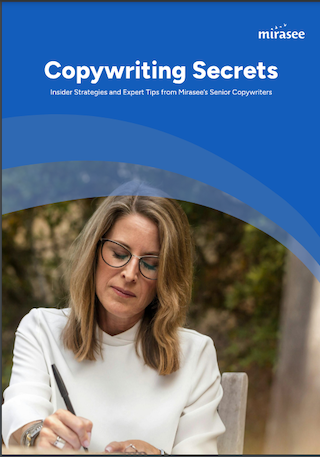How to Write Facebook Ad Copy That Converts (Guide for 2024)
Willy Wood
Have you ever noticed how some Facebook ads instantly grab your attention?
That’s no accident. Many Facebook advertisers have mastered the art of stopping readers from scrolling with arresting visuals and compelling headlines.
But just because your ad stops the scroll doesn’t mean it will convert to opt-ins or sales.
That’s because there’s a difference between clickbait ads that drive traffic but do little else and ads that convert that traffic into paying customers.
What’s the difference? Intentional, carefully crafted Facebook ad copywriting, that’s what.
And by using a handful of best practices when writing your Facebook ads, you too can consistently generate a high ROI.
In this article, we’ll share exactly what to do to ensure that your Facebook ads generate high traffic and convert into sales.
Ready? Let’s get started!
What is Facebook Ad Copy?
Simply put, Facebook ad copy is the text (copy) that accompanies the visuals in your ads. Done well, it’s the message that turns casual scrollers into eager customers.
Think of your ad copy as your friendly, 24/7 online salesperson. It’s there, reaching out to all those millions of Facebook readers, grabbing their attention and pitching your offer—and you don’t even have to pay salary and benefits!
Now, before we talk about writing your copy, let’s review. A basic Facebook ad consists of five parts:
- The Main Text: The text in the body of the post, immediately below your name. This could range from a single line to multiple paragraphs.
- The Creative: The image that sits just below your main text. Since longer text is truncated, this image usually takes up most of your ad space.
- The Headline: The bold text that appears just below the creative. Its job is to create a compelling call to action in just a few words.
- The Link Description: The description sits below the headline and allows you to insert one more reason for your reader to click on your offer.
- The Call to Action: This button text gives you one last opportunity to compel your reader to click through to your offer.
For example…
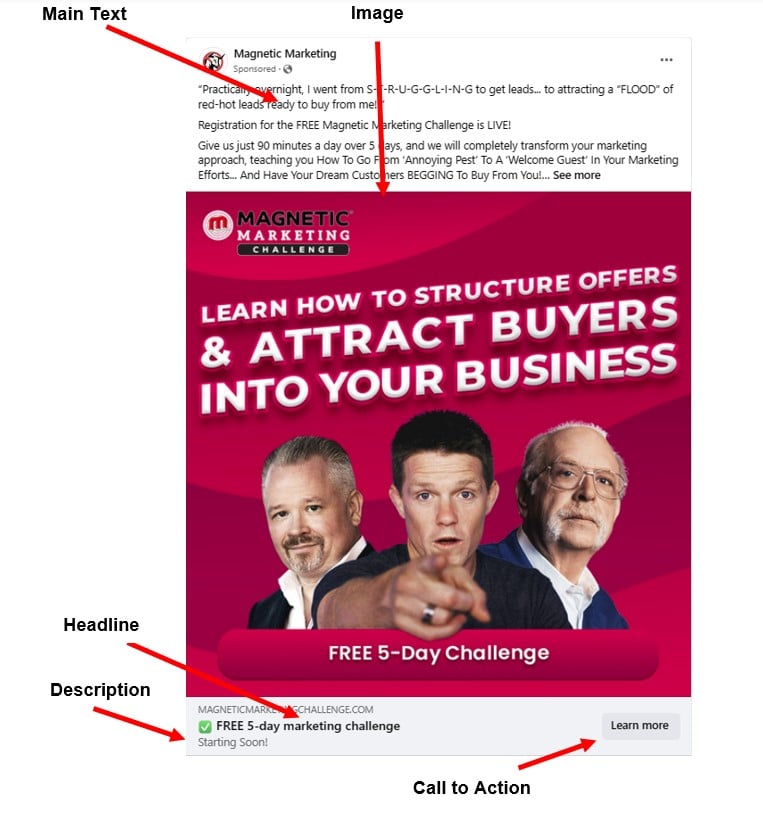
Most advertisers pay a lot of attention to selecting or creating the perfect creative but spend much less time on their copy.
That’s a mistake. After all, four of the five elements of your Facebook ad consist of words.
And while an arresting image can cause people to stop scrolling through their feed, it’s your words that ultimately drive conversions.
Why is Effective Facebook Ad Copy So Important?
Imagine you’re handed the mic at a bustling live event, but you only have 1.7 seconds to grab the attention of the people in the audience and get them to buy from you.
That’s your ad on Facebook—because the average Facebook user spends only 1.7 seconds on a piece of content before moving on. (This stat is for mobile users—it’s a whopping 2.5 seconds for desktop users.)
Your creative might grab the reader’s attention for half a second. That’s a start. But that only leaves a little over a second for your copy to hook your reader and make them stop long enough to read your entire message.
And even if you manage to make them stop and read your ad, your copy must then stir their emotions, overcome their objections, and inspire them to take action and click through to your offer—all in a few words.
It’s a daunting task, no doubt. But it is doable. And it’s definitely worth the effort.
Why?
Because according to a Facebook study done by Wordstream, businesses with active ad campaigns saw a 77% increase in followers compared to businesses not running any advertising.
Of course, the number of followers your business has isn’t a perfect measure of ad effectiveness. So how about this stat…
In the CPG (consumer packaged goods) industry, average ROI on a Facebook ad is 500-800%! So, for every $1 spent, Facebook ads in this industry return $5 to $8.
More followers and more moolah? Yes, please.
How to Write Effective Facebook Ad Copy
Hopefully we’ve convinced you that writing effective Facebook ad copy is worth the effort. That’s your “why.”
So, what about the “how”? Are you ready to learn how to connect with your audience and charm your way into their hearts (and wallets?)
If so, here’s your step-by-step guide:
1. Get Clear on Your Target Audience and What They Want
The first step in any meaningful conversation is understanding who you’re talking to.
So, to write copy that resonates, you must first take the time to learn about your audience—their aspirations, their needs, their stumbling blocks. When you know them, you can speak to their hearts.
Having a clear audience profile in front of you as you write definitely helps, so if you haven’t yet done so, create a persona representing each of the key list segments you’d like to reach with your ad.
Ask yourself questions like:
- Where do they live?
- How old are they?
- What’s the male/female mix of my audience?
- What are their job titles?
- What are their interests and hobbies?
- What does their online behavior look like?
- How much, and in what ways, do they use Facebook?
And even more importantly, ask:
- What are their biggest problems?
- What keeps them up at night?
- What kinds of solutions are they looking for?
- What’s the transformation they’d like to achieve in their lives?
Where do you find the answers to these questions? Don’t just guess or assume you know enough about your audience to answer these questions from your own head.
Instead, look at what your website’s tracking says about your audience demographics. Ask your sales team about the audience members they’re talking to. Look at surveys and polls. Or, best of all, call a few of your customers and actually talk to them. Use all the data your business has to learn more about your audience.
Once you know the key demographics and psychographics of your target audience, the next step is to leverage the amazing audience targeting capabilities of Facebook by using Facebook ads manager to build a target audience for your ad campaign.
By following this process, you’ll not only be able to write highly relevant ads that speak to your audience, but you’ll also be able to get those ads in front of your target audience to capture their attention and drive them to take action.
2. Always Start with a Powerful Hook
Every compelling story (and ad) begins with an engaging hook. Your first few lines are your golden opportunity to grab your target audience’s attention.
Think of your hook as a tantalizing movie trailer—just enough information to intrigue and excite, leaving them hungry for more (and they have to click on your call to action to learn more).
Just remember, you have only 1.7 seconds in which to do this.
The truth is, emotions move human beings. So, the best hooks are those that grab us by the emotions and don’t let go.
For example, check out this ad. You can’t tell from this screenshot, but when you scroll across this ad, the zombie crawls out of the frame at you. How’s that for grabbing your emotions?
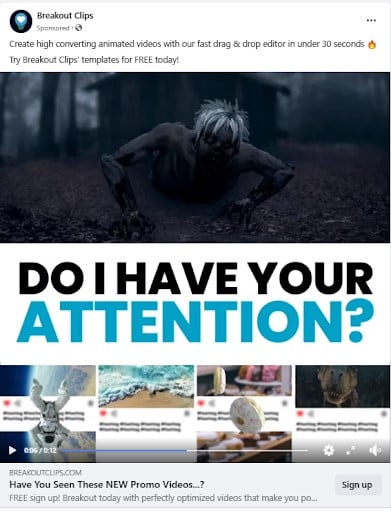
Of course, the image is the hook in that ad (which makes sense, since it’s a video product).
Now let’s look at one from Magnetic Marketing with an engaging hook in the main text. We’ve copied the text here so you can see the full pitch.
“Practically overnight, I went from S-T-R-U-G-G-L-I-N-G to get leads… to attracting a FLOOD of red-hot leads looking to buy from me!”
Registration for the FREE Magnetic Marketing Challenge is LIVE!
Give us just 90 minutes a day over 5 days and we will completely transform your marketing approach, teaching you How to Go from “Annoying Pest” to “Welcome Guest” in your marketing efforts…And Have Your Dream Customers Begging to Buy From You!
We know, we know, it’s hard to admit that your customers may be looking at you like an “annoying pest”, but stick with us here…
The cold, hard truth is that most business owners are so consumed with their offer and their uniqueness that they completely repel customers without even realizing it.
That’s why I pulled all of my resources, grabbed the best-of-the-best marketers in the world…
…and put together the one and only challenge designed to help transform you and your business from an “annoying pest” to a “welcome guest” for a flood of NEW clients, customers, or patients in 2023!
The Magnetic Marketing Challenge will teach you EVERYTHING YOU NEED TO KNOW to go from “annoying pest” to “welcome guest” and start attracting droves of your ideal customers, moving people from interested window shoppers to enthusiastic raving fans!
Click the link below to save your seat for our LIVE, free, 5-day event.
Notice the innovative spelling (“S-T-R-U-G-G-L-I-N-G”), the engaging language (“red hot,” “Magnetic Marketing,” “dream customers,” “cold, hard truth,”), the bold promise (“Give us just 90 minutes a day over 5 days, and we will completely transform your marketing approach”), and the strong call to action (“Click the link below to save your seat for our LIVE, free, 5-day event”).
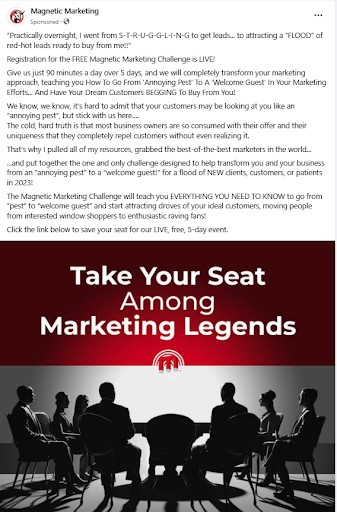
Here are some great ways to hook your audience:
- The Data/Logic Hook: Using a startling statistic or a big or highly specific number or percentage immediately lends credibility to your ad and makes what you’re about to say sound more factual and scientific.
- The Curiosity Hook: This hook piques interest early on. One way you can do this is by using questions such as “What if I told you…?” or “What would happen if…?
- The Fear Hook: Fear can be a powerful motivator. Specifically, the fear of missing out (FOMO) can be an especially effective tool for your hook.
- The Pain/Benefit Hook: This hook is simple and effective because it directly addresses your prospect’s main pain point, then suggests a solution (your product or service).
- The Empathy Hook: This hook shows that you understand your audience’s problem and makes them feel like they aren’t alone. It also demonstrates that you care, which is one of the quickest ways to get your audience to know, like, and trust you.
3. Address Your Audience and Pique Their Curiosity in Your Intro
One of the most effective ways to speak to your audience is to pretend like you’re having a chat with them at your local Starbucks. Don’t just talk to your audience, engage in a conversation with them. Make them feel seen and understood.
In addition to this friendly, conversational tone, look for ways to pique your readers’ curiosity in your main text section.
You could do this by asking an intriguing question. Or you could do a pop quiz in Messenger. Or you could tell the beginning of a story but leave an open loop (“To learn the rest of the story…”).
Whatever approach you go with, look for a way to spark their curiosity without being overly hypey. Hype is a curiosity killer.
4. Acknowledge Their Challenges and Show Them How Things Could be Different
Empathy builds trust.
Show your audience that you understand their struggles. Then, paint a picture of a brighter future with your solution.
One simple writing hack that you can use to forge this emotional connection with your audience is called “Before-After Bridge.” It works like this:
- First, describe the current situation where a problem exists (before).
- Then, help them imagine a world where this problem no longer exists (after).
- Once you’ve described the current reality and the vision, you then present the bridge from one to the other, which is your solution.
To solve their problem and achieve the transformation they’re looking for, all the reader has to do is cross the bridge (take you up on your offer).
Here’s the (expanded) text for an ad that uses a variation of this approach…
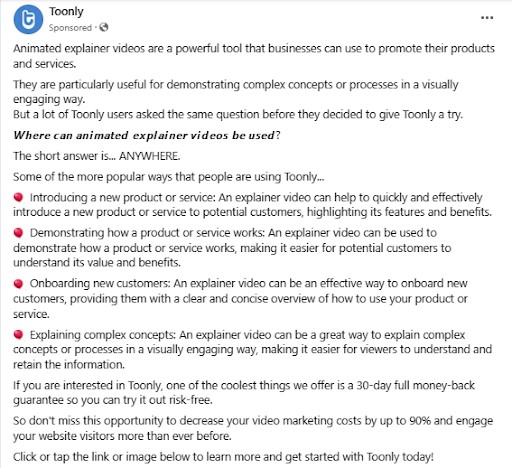
The “before” situation is that people have a problem because they don’t know how they could use explainer videos in their businesses. The “after” situation (in this case, multiple after situations) are the various ways they can now envision using explainer videos after reading the bulleted list. And, of course, the bridge is the product, Toonly.
5. Motivate the Reader to Take Action with Your CTA
People are more likely to take the action you’re hoping for if you tell them exactly what to do—whether that’s to watch your video, opt into a list, or purchase.
If the rest of your ad has done what it’s supposed to do (make the reader curious or get them excited), your call to action is the moment of truth.
Make it clear, compelling, concise (no more than three words if possible), and impossible to resist. Done well, your CTA is the final push that gets the click.
Obviously, Facebook provides a call-to-action button in the ad itself below the image, but another good practice is to also put a CTA in the text for people who are readers.
Or, put another CTA link in the image itself. We’re kind of partial to this one (bottom right of image) …
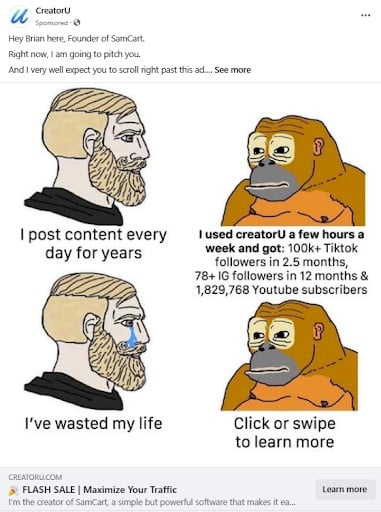
6. Don’t Forget About the Text in Your Ad Images
Yes, a picture is worth a thousand words, but the right words added to a picture can make it priceless. That’s why it’s important to use text in your ad images to complement and amplify your copy.
Clearly, your image is what’s most likely to get readers’ attention and stop them from scrolling. People tend to consume the image first before checking out the accompanying text.
But when you add text to your images, that text becomes, in essence, part of the image, meaning that it will most likely be the first text people read in your ad.
Obviously, this means that you want to find a way to place your key message on your ad images, where it will be seen right away.
But before you go loading up your Facebook ad image with copy, you need to understand that Facebook prefers ad images with little text because they believe that images with a lot of text may create a lower-quality experience for readers.
Facebook once even had a policy where copy wasn’t allowed to overlay more than 20% of an image. “Text” in this case also included text-based logos, watermarks, and even text in your video’s thumbnail images.
Now, that policy no longer exists, but it still makes sense to keep the text you add to your images concise and on point.
To learn more about the history of the 20% rule, why it went away, and what are now considered best practices for using text overlays in your ad images, check out this helpful post from Hubspot.
7. Make Sure the Copy Matches the Ad Images
Your ad copy and images should be like peanut butter and jelly—a perfect match. They need to tell the same story, evoke the same emotions, and drive the same message home, each in its own way.
If your ad campaign doesn’t come across as cohesive, it’s a huge turn-off for many Facebook users. So, take some time to find or create an image that visually conveys the gist of the message you’ll be sending in your copy.
You want to get this right because most social platforms are heavily visual.
People expect to see clear, high-quality images, and if your image is blurry or so posed that it comes off as fake, your readers will be instantly turned off and you won’t get good engagement from your ad campaign.
So, what makes for a good image in Facebook’s eyes? Thankfully, you don’t have to figure this out by yourself through trial and error. Facebook provides clear guidelines in its Best Practices for Image Ads article.
But again, finding or creating a high-quality image isn’t the most important thing. The key consideration is, “Does the image send the same message as the copy?”
For example, in this post from a company that promises to create valuable social media content that doesn’t bore your followers, the point made by the text is reinforced by the image and vice versa.
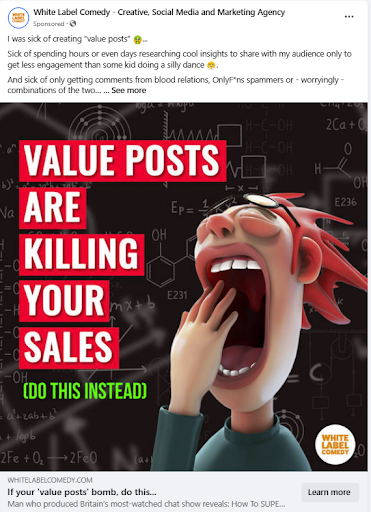
8. Ensure Your Ad Headline and Description are Clear and Concise
In the world of ads, brevity is beauty. Your headline and description should be like an elevator pitch—quick, crisp, and clear. Remember, Clarity always outperforms complexity.
When you’re writing a headline for your Facebook ad, think about these factors:
- Think CTA: In other words, think of your headline as a first call to action that drives people to your second call to action on your CTA button. Think, “write for the click.” One good approach is to try to make the first word of your headline an imperative verb.
- Connect “What” and “Why”: If you start with an imperative verb (what you want your reader to do), follow that up with a benefit (why they would want to do it). Or…
- Ask a Question: As an alternative to stressing a benefit, you can ask a relevant question that begs for a response. Or…
- Make a Promise: Yet another option is to make a promise that your product or service fulfills.
- Focus on One, Specific Idea: We’ve already said that your entire ad should be designed to make a single point. Your headline should make that point once again. Don’t say your product or service is fast and easy, or that it saves people time and money. Pick one or the other.
- Use Numbers and/or Special Characters: These things catch people’s eye because they break the flow of reading letters. Don’t say you’ll save people “over a thousand dollars,” say “over $1000.” Better yet, combine this tip with specificity—“You’ll save $1,127.98.”
- Focus on clarity: To engage users in your ad copy, it is necessary to ensure maximum clarity. Try to make use of commonly known words & phrases and simple sentence structure. If you are not able to do so, then reword the ad copy with an online tool.
- Keep it Short: The average headline length for a Facebook ad is five words, so shoot for that. If you can follow the guidelines above and do it in less than five words, do so.
As far as your description text goes, this is a great place to…
- Mention something about the offer, including any incentives. This could be free shipping or a downloadable ebook as a bonus.
- Nudge the reader to act by highlighting scarcity in your description text (“Limited Availability”).
- Or, provide a push by highlighting urgency (“Offer Ends Sunday”).
At this point, you may be wondering, “How do I achieve all these goals (hook the reader, create curiosity, excite them, provide a compelling call to action, and pump up the scarcity and urgency) in the short amount of space I have in an ad?”
It’s a good question, one that even professional copywriters struggle with.
But here’s one important tip to remember: In most cases, the job of your ad is NOT to convince readers to buy; it’s just to get them to click your call to action button. That’s it. Once they do that, they will be taken somewhere else (a landing page, a blog post, an opt-in form) where the final pitch will be made.
So, don’t put pressure on yourself to try to sell your reader in your ad. All you have to do is intrigue them enough to get them to click. And you can do that even with short copy if you follow the tips in this article.
9. Don’t Forget to Track Your Facebook Ad’s Performance
Remember, what gets measured gets improved. So, you’ll need to keep an eye on your metrics to understand what’s working and what’s not.
With the technology available to you for your Facebook ad campaigns, there’s really no reason to try only a single version of your ad.
Instead, try multiple versions and check the metrics on each one with a Facebook Ads reporting tool. Then drop the losers and continue to tweak the winners, changing different parts of your ads and monitoring how each version performs. The more versions you test, the better your chances of finding a version that converts at a high level.
Now, that’s all good in theory, but you may be wondering exactly how to make it work in practice. To do so, you’ll need to know two things:
- What metrics to measure and
- What order to test the different elements of your ad.
Let’s talk metrics first…
Many marketers get caught up in looking at vanity metrics such as likes or comments, but those aren’t the best criteria upon which to base your conclusions. In fact, many an ad has generated lots of likes and comments and led to virtually no conversions.
No, the best way to measure the success of an ad campaign is to judge it based on the goal(s) of the campaign. Here are some key metrics to measure:
- Ad Frequency: This is how many times Facebook users saw your ad. If your goal is to increase brand awareness, you likely want your frequency to be around 3-4 times per viewer. But if you’re trying to convert readers into opt-ins or buyers, you’ll want to keep this number low—1 or 2. Otherwise, you risk annoying people who don’t wish to take you up on your offer.
- Cost-Per-Click (CPC) or Cost-Per-Result (CPR): Facebook either charges you per impression or per click, depending on which option you choose. If you’re just starting, cost-per-click is more budget-friendly. If your ad is working, the dollar amount should start to go down over its run time. Generally, you want your chick-through rate to be $2 or less. If not, try adjusting your campaign’s targeting, run time, or whatever you think is driving the cost up.
- Reach and Results: Reach tells you how many different people are seeing your ad. Initially, you want to have a wide reach to raise brand awareness. Over time, though, you’ll want to eliminate waste in your reach, such as people in demographics that aren’t a good fit for your offer. As your ad becomes more targeted, you should see your results improve.
These aren’t the only metrics you can measure, of course. You’ll also want to make sure you’re measuring the metrics that best indicate success according to the goals you’ve set for your ad, which could be anything from opt-ins to webinar signups to units sold.
OK, so now that you know what you’ll be measuring, what do you do when you get those metrics? If an ad is underperforming, what elements of the ad should you test?
Here are some guidelines:
- Test your images first. Even though this article is primarily about how to write more effective copy for your Facebook ads, we’ve also mentioned several times how important your images are to your ad’s success. In fact, it has been found that your images are responsible for some 75 to 90% of your ad’s performance. As a result, it makes sense to always test your images before testing different elements of your ad copy. Test 10-15 different images, keeping the copy the exact same across all versions. Once you’ve found a winner…
- Test your headline next. Besides any copy you might overlay on your images, your headline stands out most. Many readers will just skim your main text and move right down to the headline to get the gist of what you’re offering. So again, come up with at least 10 versions that follow the guidelines we went over in the previous tip. Keep everything but the headline the same and test each version. Find a winner.
- Next, keep your winning image and headline and test a number of different CTAs. Finally, once you’ve found a winner…
- Test several versions of your body copy.
Yes, this process takes some time, but it will pay off big in the long run. With each refinement in your ad, you’ll see incremental (and sometimes radical) improvements in your target metrics.
Use These Facebook Ad Copywriting Tips and Stop the Scroll!
There you have it—your roadmap to creating Facebook ad copy that stops the scroll and drives conversions.
Mastering Facebook ad copy can be a game-changer for your business.
But it’s not just about peddling your wares; it’s about establishing connections, stirring emotions, and delivering real value. Do this for your audience, and do it consistently, and you’ll not only build a business, but you’ll also build a following.
But remember, like any skill, writing ad copy takes practice. So, roll up your sleeves, get creative, and start writing. Your audience is waiting!
Elevate Your Copywriting Game!
Discover winning strategies and insider tips for writing words that sell - from Mirasee’s very own expert copywriting team!